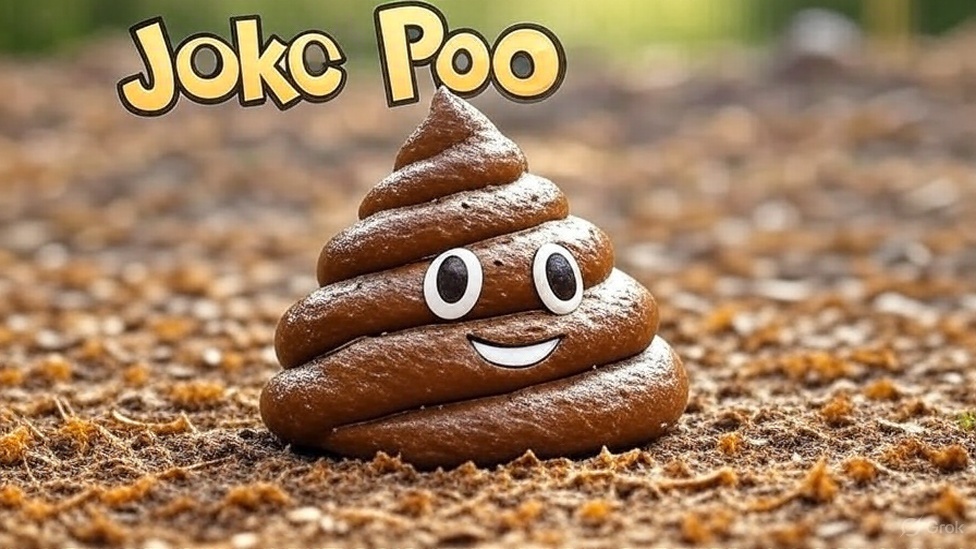He freaks out and goes to see a doctor to find out what the rings are. The doctor examines them and says "I have good news and bad news. Which do you want first?"
The man asks "What's the good news?"
Doctor "The red ring is lipstick. Just ordinary red lipstick."
Man "Oh that's great! But what's the bad news?"
Doctor "The bad news is the brown ring is tobacco chew spit…"
Joke Poo: The Archaeologist’s Find
An archaeologist is painstakingly brushing dirt off a newly unearthed artifact. He discovers a small, ancient clay tablet depicting a peculiar symbol: a spiral shape within a larger circle. He also notices two distinct stains on the tablet, one reddish-brown, the other a murky green.
Excited, he takes the tablet to the university’s leading expert in ancient symbology. The expert examines the tablet with a magnifying glass and says, "I have good news and bad news. Which do you want first?"
The archaeologist asks, "What’s the good news?"
Expert: "The reddish-brown stain indicates the tablet was once sealed with high-quality, imported resin. It’s a sign of considerable importance!"
Archaeologist: "Oh, that’s fantastic! But what’s the bad news?"
Expert: "The bad news is the murky green stain is guacamole… Someone clearly enjoyed their lunch while working on this."
Alright, let’s dissect this little gem.
Core Elements:
- The Setup: Classic amnesia-fueled, "where am I, what happened?" scenario. The missing pants and painted…anatomy…immediately inject a strong dose of absurdity and potential embarrassment.
- The Doctor Visit: Shifts the tone to a slightly more clinical, "seeking answers" vibe, allowing for exposition and the inevitable punchline delivery.
- The Good News/Bad News Trope: A well-worn comedic device that builds anticipation and sets up a stark contrast, maximizing the impact of the punchline.
- The Punchline: The unexpected and disgusting revelation of the brown ring’s origin. The juxtaposition of lipstick (relatively harmless) with tobacco chew spit (utterly repulsive) is the comedic engine here. It’s a "gross-out" joke relying on the yuck factor.
- Implied Narrative: The humor also rests on the implied debauchery of the previous night. The audience fills in the gaps, imagining the circumstances that led to this…artistic expression.
Comedic Analysis:
The joke works because it escalates from mild concern to abject horror. The "good news" lulls the listener into a false sense of relief before sucker-punching them with the truly awful reality. It plays on societal disgust reactions and the inherent taboo of bodily fluids.
Now, let’s enrich! Here are a few options:
Option 1: The "Did You Know" Enhancement
Did you know that the average person produces about 1-1.5 liters of saliva per day? Imagine all the artistic opportunities that opens up! Though, admittedly, I’d still prefer lipstick to tobacco spit as a medium. Makes that red ring seem like a veritable masterpiece, doesn’t it?
(This adds a factual element about saliva production and then circles back to amplify the disgusting element of the joke.)
Option 2: A Witty Observation
That doctor in the joke? Total sadist. He knew exactly which order to deliver that news to maximize the trauma. A real professional in the field of comedic medical malpractice. I bet he bills extra for emotional distress.
(This shifts the focus to the doctor’s character, implying a dark sense of humor and questionable ethics.)
Option 3: A Related Joke
Why don’t scientists trust atoms? Because they make up everything! …Which reminds me of that poor guy who woke up with a red and brown ring on his…well, you know. The red ring was lipstick, the brown ring was chew spit. Turns out, the artist was just trying to create a minimalist representation of molecular gastronomy.
(This uses a pun-based setup and connects it to the joke’s punchline, adding a layer of intellectual humor (or at least the attempt thereof) to the original’s gross-out factor.)
Option 4: A "What If" Scenario
Imagine if the doctor had continued, "And the really bad news? The tobacco spit wasn’t from a person. It was from a goat. Who also had lipstick on." Then you’re not just dealing with bodily fluids, you’re venturing into interspecies shenanigans and a whole new level of existential dread.
(This pushes the boundaries of absurdity, adding another layer of unexpectedness and amplifying the "what the heck happened last night?" theme.)
Choose the option that best suits your audience and your own comedic sensibilities! Remember, comedy is subjective, and the goal is to make people laugh (or at least grimace in amusement).


